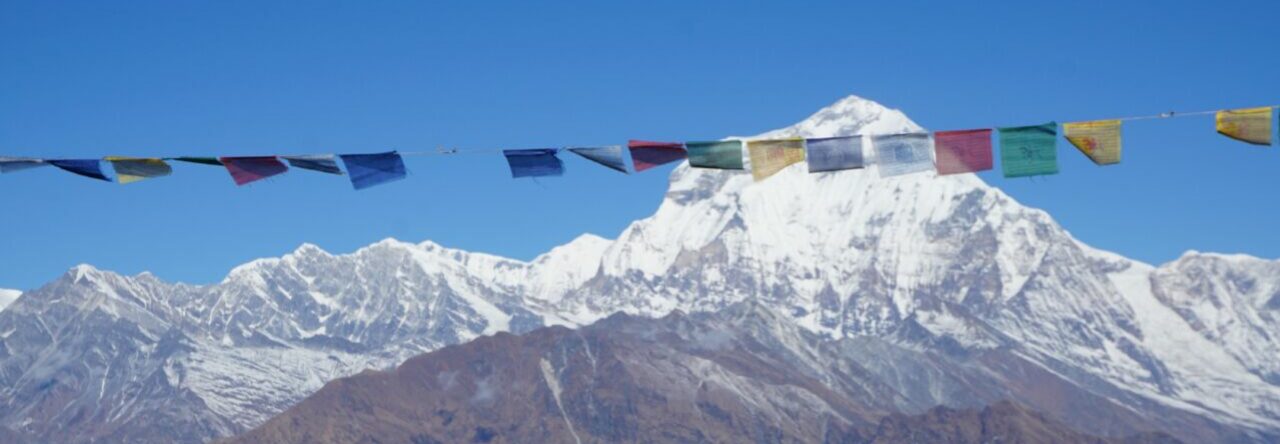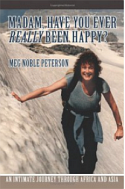March came in like a lion here in Dharamsala, but now we have clear skies and balmy weather and absolutely no complaints. This is a magical place! Picture thousands of monks in maroon, orange, or yellow robes, depending on their country, and add to that hundreds of people from Tibet, Asia, Western Europe, the U.S., Canada, South America, and every country where there are pilgrims eager to hear the Dalai Lama‘s teachings. And imagine all these people sitting on mats in the vast open-air piazza of the Namgyal Temple with yellow columns separating various groups, a bright yellow canopy on which is woven many replicas of the endless knot (one of the eight auspicious Buddhist symbols), fluttering over one section, and the Tibetan flag waving proudly halfway between two sturdy trees. More trees, huge firs, grace the remainder of the open area.
I walked three times around the second level of the temple early this morning, doing the kora. The sun glistened dramatically on the Himalayan peaks, which looked close enough to touch, but a bit too threatening to climb just yet. The monks were chanting, producing a low, rich sound so different from the Hindu chanting in Lakshmanjhula. The deep guttural bass boomed forth intermittently, followed by repetitive prayers, which ended with a heavy downward slur, like a record winding down. Then it would begin again, in a slightly higher key. I walked past several banks of large bronze prayer wheels. Shoes were piled next to the monks, who sat cross-legged on the floor. An incongruous sign in English and Tibetan caught my eye and I smiled: Make sure your shoes are not stolen. In a temple no less.
We were all searched and had to show our identification badge, which had been obtained at the security office beforehand. This was a thorough search, for security was tight. Once inside it was a sea of color, and amazingly orderly and quiet. We were all grateful for the good weather where the multi-colored umbrellas could be used for the sun, not the rain.
At 9 A.M. the Dalai Lama appeared and walked slowly down the center aisle flanked by monks. He bowed slightly, gesturing to friends, smiling, and greeting the throng. There was no elaborate pomp and circumstance. Just silence. The crowd was visibly moved and acknowledged him with their hands in a prayerful position. The same thing occurred at the end of each session, sometimes accompanied by low chanting and once with some kind of reed instrument. It was a quiet, dignified procession.
His Holiness sat on a large raised seat and talked without notes for two-and-a-half hours in the morning, and, again, in the afternoon. Butter tea and rolls were dispersed both in the morning and in the afternoon by monks carrying large tea kettles. Sometimes milk tea was substituted.
People had selected their “spaces” four days in advance and taped their names to the floor. A very old Tibetan lady, creased, toothless, and bent, muscled into my space, but we all managed to accommodate her and she has now become somewhat of a mascot. We move around, however, and today I sat very close to the Dalai Lama and watched, with utter fascination, as he moved and gestured, punctuating his speech with highs and lows and the deep laughter the West has found so endearing. His delivery is animated, powerful, and mesmerizing. He is, indeed, a great teacher. The interpreter, a young monk educated at Oxford, is brilliant and, to my delight, sits near my space. I’m fascinated by how he can simultaneously translate the complexities of Buddhist theology so eloquently and interpret the non-stop commentary, which is based on the teachings of the Third Dalai Lama (being used as our text). There are also French and Portuguese interpreters.
It’s now the fifth day of the teachings and I’m profoundly moved and inspired. These are not simple concepts, nor is this beginning Buddhism. It deals with 2500 years of history and the application of the Buddhist message of compassion and love in this troubled world. The Dalai Lama is a master storyteller and sometimes I turn off my FM radio and just listen to the timbre of his voice. The repetitions, the change in tone, the inflections. For me it is high drama and every moment is electric.
Outside the temple it’s a carnival. Food vendors, honking taxis trying to shove their way through intransigent crowds, beggars under foot, hawkers. Cary and I have found some fabulous Indian and Tibetan restaurants and some interesting new friends. At our guest house just up the hill from the temple are three Canadians, Doris, Jan, and Louise, two captivating Hollanders, Trees Muijlaert, and Joris Broeders, and an occupational therapist, Laura Simonian . Close by is a friend we met at Majnu Ka Tilla in Delhi, Tamara Blesh, who is a high school library technology specialist in Gardiner, Maine and is on her way to Ladakh to set up a library at Siddhartha School in Stok, 18 Kilometers south of Leh. A talented and interesting lady, who also sponsors a Tibetan student inside Tibet.
We’ve had the privilege of spending time in the home of Tenzin Youdon’s family just after Joser, the Tibetan New Year. Tenzin married an American who lives on Whidbey Island, and Cary delivered gifts to her parents and sisters, who, coincidentally, live just up the lane from our guest house. Their son is a rinpoche and two of the five daughters are living in the U.S. It was an emotional meeting as they talked about their absent children. This is a typical, very close Tibetan family.
Our most poignant experience this past week, however, was a visit to the TCV (the Tibetan Children’s Village) school in Dharamsala, a non-profit, charitable institution for the care and education of orphaned and destitute Tibetan children in exile. Cary, Martha, my grandchildren, and I, plus friends in Maplewood and Whidbey Island sponsor students at this school and the one in Suga, near Bir. The stories of their escape from Chinese oppression is well-documented and widely known, and these children are still coming across the border in ever-increasing numbers and at great cost in human suffering.
We met with Cary’s friend, Dolma Lhamo, formerly of the Suja school, and now the secretary for the sponsorship program coordinator of the Dharamsala school, Tashi Lhamo (no relation). Both women are dedicated educators whose lives are spent insuring that there will be a home for these youngsters, while at the same time they are preserving the rich heritage that is being obliterated in Tibet by Chinese persecution.
We met Martha’s sponsored “son,” Lhakpa Wanghal, an 18-year-old physics and biology student whose parents smuggled him across the border when he was only four, the youngest of six children. They wanted at least one of their children to have a future. This young man is extraordinary! He showed us his academic work and his extra-curricular projects. He had designed his own logo. and in large letters incorporated the school motto underneath: Others Before Self.
These schools are run like large families, with surrogate mothers and the children referring to one another as brother and sister. All classes from the 5th grade on are in English and the education is first rate. Many children, like Lhakpa, have not seen their parents since they left Tibet, and many never will.
I urge you to visit their website and find out more about this amazing network of schools. www.tibchild.org
I mentioned before that the owner of our guest house is a young Tibetan man named Pema Yeshe. He is also the librarian at the foreign language section of the Library of Tibetan Works and Archives here in McLeod Ganj. Cary and I walked through the woods and down the steep slopes with Pema to visit this beautiful library. We were shown ancient manuscripts that had been carried out of Tibet at the time of the Dalai Lama‘s escape in 1959. Some were written in simple block print and others were executed with gold hand-lettering. These were long, narrow rectangular pages wrapped twice in orange, then yellow cloth and tied carefully to preserve them. A large room held thousands of these precious manuscripts.
The building also housed a museum with a superb collection of artifacts that have been smuggled out of the country since the Chinese invasion of Tibet. Most of these were given to the Dalai Lama, who, in turn, entrusted them to the museum. Others can be found in famous museums throughout the world. There were two unusual mandelas, one in colored sand and one in three dimensions, as well as a superb butter statue of the Potala Palace in Lhasa.
Pema told us a great deal about the history of Buddhism, and one thing I found interesting was that the prayer flags we so often identify with Buddhism were really flags used by the Bon religion, which was being practiced at the time Buddhism was introduced into Tibet.
After leaving the library, we visited the Nechung Temple of the Oracle of Tibet, which was close by.
Every day we wander on new paths, through woods that are finally heralding spring as trees of blood-red rhododendron blossom on the hillsides. Each morning the mountains greet us, white and radiant. And although we are just above the temple, it’s quiet. We are in a world totally isolated from the frantic bustle of main street.


Judy Wyman
Hi Meg! So glad to see that you made it to Ramana’s Garden. Can’t wait to hear more about it! Kisses to you and Cary. Love, Judy
sirensongs
I also really enjoyed and appreciated Ramana’s Garden and blogged about it in 2006. A worthy place.
Tenzin Tseyang
I LOVE READING THIS